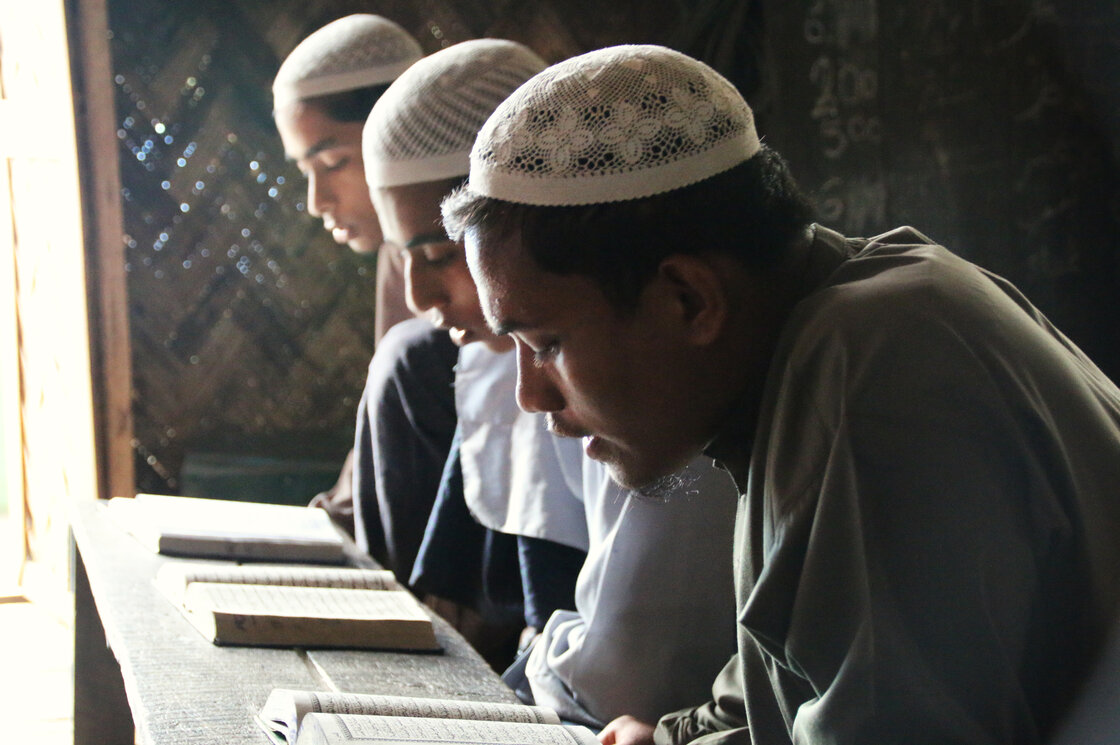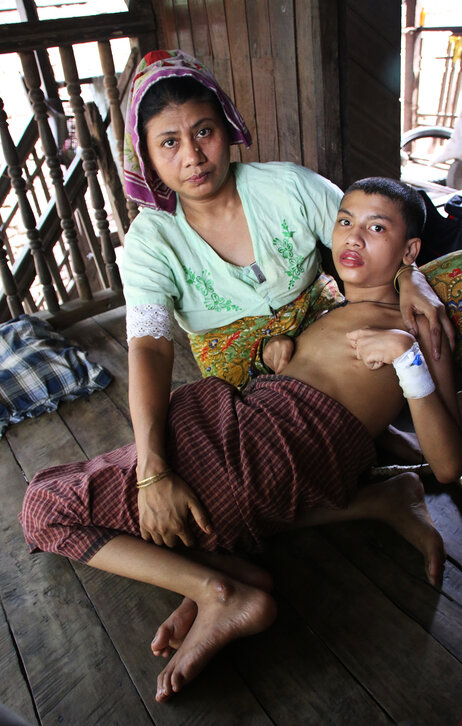
Muslim Rohingya women are pictured at the
Thae Chaung camp for internally displaced people in Sittwe, Myanmar, on
April 22. The stateless Rohingya in western Myanmar have been confined
to the camps since violence erupted with majority Buddhists in 2012. The
camps rely on international aid agencies, but still lack adequate food
and health care.
Thirteen-year-old Zomir Hussein lives with his family in a simple
wooden home in a village outside the city of Sittwe, the capital of
western Myanmar's Rakhine state. Not long ago, he accidentally overdosed
on medicine he was taking to treat his tuberculosis.
Now he
lies on the floor, his hands curled into claws, his eyes staring
vacantly. He cries out to his parents for help. His mother cradles him,
and for a moment, he seems to smile.
Zomir was getting
treatment at the main hospital in downtown Sittwe. Then, in June 2012,
violence between Buddhist Rakhine people and Muslim Rohingya broke out,
killing about 140 people. Zomir's father, Mohamed Hussein, says he
hasn't been able to take his son to the hospital since then.
Zomir Hussein, 13, suffers from the effects of an accidental overdose of tuberculosis medicine. Because he is Rohingya, he is unable to go into Sittwe to the only hospital that can treat him. Most Rohingya are confined to camps for internally displaced persons, where there are few doctors.
Anthony Kuhn/NPR
That's because the family is Rohingya, and they are now effectively banned from going into downtown Sittwe.
"We
called the doctor and asked for his help," Hussein remembers. "He said:
'I can't go to you to treat your son, and you had better not come to
see me. If you do, the Buddhist mobs will kill both of us.' "
"The
police and military stop buses at their checkpoints, and if they see
any Rohingya aboard, they pull them off," Hussein adds. "Outsiders don't
know about our situation here. It's like living in a jail."
Half
a century of military rule in the southeast Asian country of Myanmar,
also known as Burma, ended in 2011 — and with it, the suppression of
long-simmering conflict between different ethnic groups.
Now,
two years after the violence between Buddhists and Muslims in western
Myanmar broke out, no quick resolution to the ethnic and sectarian
conflict is in sight. Thousands of stateless Muslim Rohingya people
remain .
The United Nations says the Rohingya are one of the
world's most persecuted peoples. The Rohingya and human rights groups
say Myanmar's government has targeted them for ethnic cleansing, and a
recent report from rights group Fortify Rights documents how .
But
the conflict's history is extremely complex, and it is often overlooked
that it is just the latest chapter in the story of two minority ethnic
groups — the Rohingya and the Buddhist Rakhine minority that have
coexisted in the area for centuries. The U.N. says the Rakhine people
have legitimate grievances that also must be addressed.
The
government of Buddhist-majority Myanmar refers to the Rohingya as
Bengalis. It considers them illegal immigrants from Bangladesh, not
citizens of Myanmar. In a recent nationwide census — the first in 30
years — people who identified themselves as Rohingya were simply not
counted.
Rohingya are discriminated against because of their religion and their race. Other groups often refer to them as kalar, a racial slur aimed at people of darker skin color.
The
ethnic violence in 2012 displaced about 146,000 people in Rakhine
state. Most of them are Muslims living near Sittwe, but there are some
Buddhists, too. But unlike the displaced Rohingya, the Buddhists are
free to move around at will.
There are an estimated 1.3 million
Rohingya in Myanmar, out of a total population of more than 50 million,
mostly Buddhists. In Rakhine state, Rohingya are the second largest
ethnic group after the Rakhine.
Buddhist nationalists led by cite the violence in Rakhine state in pressing for they say are intended to protect their religion.
Violence Spreads
Last year, .
Three days of rioting in the town of Meiktila left 46 people dead and
1,500 homes destroyed. There, the Muslims are mainly ethnic Indians.
A camp for displaced Rohingya people sits by a river outside Sittwe, the capital of western Myanmar's Rakhine state. Rohingya are not able to travel freely outside the camps.
 The history and origins of the Rohingya are a matter of debate,
but many sources agree that for centuries, they were subjects of a
Rakhine kingdom that included much of current-day Myanmar and
Bangladesh. The area has long been a complex tapestry of ethnic groups,
some Muslim and some Buddhist, and Myanmar itself has long been a
melting pot of peoples from South and East Asia.
The history and origins of the Rohingya are a matter of debate,
but many sources agree that for centuries, they were subjects of a
Rakhine kingdom that included much of current-day Myanmar and
Bangladesh. The area has long been a complex tapestry of ethnic groups,
some Muslim and some Buddhist, and Myanmar itself has long been a
melting pot of peoples from South and East Asia.
The Rohingya were officially deprived of citizenship under a enacted by the then-ruling military junta.
That
has resulted in a legacy of neglect. Aid agencies say nearly half of
the displaced people in Rakhine state lack reliable access to safe and
nutritious food. The Rohingya camps — which are patrolled and guarded by
soldiers — have only rudimentary medical clinics with few skilled
doctors. For people in the camps, .
Unable to trade overland
because of travel restrictions, many Rohingya take to the sea. At one
fishing port on the Bay of Bengal, the wooden boats leaving the port are
often crammed with Rohingya fleeing to Thailand, Malaysia or Indonesia.
Some of the rickety craft have gone down at sea.
Fish dry in the sun at a Rohingya camp outside Sittwe. The camp's bamboo houses are only meant to last two or three years, and the international aid agencies that built them had no intention of creating permanent settlements.
 In a nearby camp for displaced Rohingya, I met a young man named
Mohamed Faisal. He says he paid a human smuggler to get him to Malaysia,
but he couldn't find a job there. On the way back, he says his boat ran
out of food, so he jumped ship and swam part of the way home.
In a nearby camp for displaced Rohingya, I met a young man named
Mohamed Faisal. He says he paid a human smuggler to get him to Malaysia,
but he couldn't find a job there. On the way back, he says his boat ran
out of food, so he jumped ship and swam part of the way home.
He
says the discrimination, restrictions on movement and lack of basic
services for the Rohingya make life in the camps unbearable.
"There's
nothing here, no jobs, no food and no medical care," he complains.
"What can we Rohingya do except leave and go to another country?"
Few Schools For Rohingya
At
a local Islamic school, students dressed in long robes and white
skullcaps rock back and forth as they recite from the Quran. Most of
them are displaced Rohingya, and this madrassa is one of the few places
they can get an education. Sittwe has its own university, but since the
2012 violence, Rohingya have been barred from studying there.
A young teacher named Mohamed Idris says that the Rohingya will remain patient in the face of government neglect.
"We
teach our students that they are citizens and indigenous to Myanmar.
There's no need for them to flee to other countries," he says. "For
example, I have documents that show that my forefathers were born and
raised here."
Rohingya students recite from the Quran at a madrassa, or Islamic school, outside Sittwe. About 70 percent of the students at the madrassa are internally displaced persons. Their options for education are limited, and Sittwe University stopped admitting Rohingya students after 2012.
Anthony Kuhn/NPR
 But the mostly Buddhist Rakhine people see it differently. Rakhine
community leader Than Tun argues that the illegal Bengali immigrants,
as he calls them, should be detained and then sent back to where they
came from. He adds that the children of illegal immigrants are just as
illegal as their ancestors.
But the mostly Buddhist Rakhine people see it differently. Rakhine
community leader Than Tun argues that the illegal Bengali immigrants,
as he calls them, should be detained and then sent back to where they
came from. He adds that the children of illegal immigrants are just as
illegal as their ancestors.
"Many Bengalis immigrated here in
the 1940s," he says during an interview at his home in Sittwe. "Now
these illegal immigrants have died off. But they have many children who
remain, and they, too, are illegal immigrants."
Than Tun and
other Rakhine are also dissatisfied with the U.N. and foreign aid groups
and the media, which they believe have sided with the Rohingya against
them. Than Tun says the foreign aid has only enticed more illegal
immigrants to flock to Myanmar. Rakhine point to previously
Buddhist-majority border towns near Bangladesh, which are now mostly
Rohingya, thanks to a border that is porous in places, and immigration
officials that can be bribed to look the other way.
Aid Group Kicked Out
In
April, angry Rakhine residents attacked aid agency offices in Sittwe
after one agency staff removed a Buddhist flag, and some foreign aid
workers had to be evacuated. In February, the government ejected
Medecins Sans Frontieres from Rakhine state, claiming that it was giving
preferential treatment to the Rohingya. .
Than Tun also points
out that like the country's other ethnic minorities, the Rakhine have a
distinct identity and language and that they were also suppressed by
the junta.
And like other ethnic groups in Myanmar, he says,
the Rakhine are still fighting for autonomy and control of their own
natural resources. to move oil and gas from Rakhine state all the way across Myanmar and into southwest China.
"We
Rakhine had our own empire, which was more ancient than the Burmese,
but we lost it when the Burmese invaded" in the late 18th century, he
says. "We have been ruled by the Burmese military government, and again
were not free. This is why we have our own armed insurgent groups."
In a suggestion that the Rakhine conflict may be paying political
dividends to the central government, Myanmar media have reported that
two Rakhine insurgent groups which have been fighting government troops
have now and keep illegal immigrants out.
Opposition leader
and human-rights icon Aung San Suu Kyi has not put up much opposition to
the government's treatment of the Rohingya. During her 2012 visit to
Oslo, Norway, to collect the Nobel Peace Prize she could not pick up
while under house arrest in 1991, I asked her if the Rohingya were
citizens of her country. .
Myanmar's democratic and economic
reforms haven't really taken root in ethnic minority areas where
insurgencies still simmer. Myanmar is one of Asia's poorest countries,
and Rakhine is the second poorest state in Myanmar.
Even as
overall relations between Myanmar and the U.S. move ahead, President
Obama recently cited human rights abuses in Rakhine state as one reason
the U.S. is extending some economic sanctions on Myanmar for another
year.
Source: here


No comments:
Post a Comment